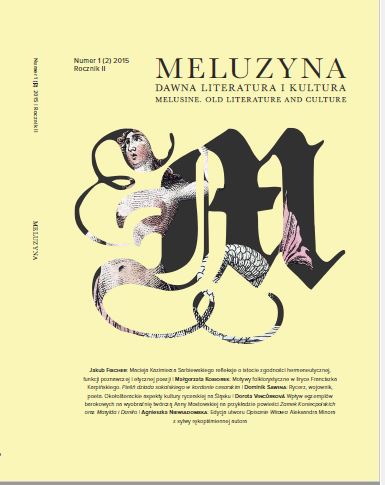Penelopea Jana Achacego Kmity wobec Listu 1 św. Hieronima ze Strydonu oraz Zuzanny Jana Kochanowskiego
Jan Achacy Kmita’s “Penelopea” in relation to St. Jerome of Stridon’s “Letter 1” and the poem “Susanna” of Jan Kochanowski
Author(s): Karolina WójcigaSubject(s): History, Language and Literature Studies, Studies of Literature, Polish Literature
Published by: Wydawnictwo Naukowe Uniwersytetu Szczecińskiego
Keywords: Jan Achacy Kmita; “Penelopea”; St. Jerome of Stridon; Jan Kochanowski; “Susanna”; biblical paraphrase; exemplum
Summary/Abstract: The paper focuses on the poem “Penelopea or the innocence of the strangely wonderful maidensev’n times tortured. Previously by Jerome the saint, now by Jan Achacy Kmita described”(Penelopea abo niewinność dziwnie cudownej niewiasty siedm razy ciętej. Przedtym przez Hieronimaświętego, a teraz przez Jana Achacego Kmitę opisana) by Jan Achacy Kmita (ca. 1560 –ca. 1628). The 1610 text is a poetic paraphrase of “Letter 1” by St. Jerome of Stridon. This paper presents the methods of Kmita’s translation and situates “Penelopea” in relation to “Susanna” byJan Kochanowski. The translator has particularly accentuated the drama of the plot (characterized by the presence of numerous expressivisms), locating the macabre episodes in a small-townscenery. Both “Susanna” and “Penelopea” can be described as poetic exempla, however Kmita’sepyllion is devoid of topics of providence and divine justice, unlike Kochanowski’s text. Kmitafocuses on the epic hic et nunc, the symptoms of wonder, marvel, and cruelty, and draws from them a parenetic conclusion of persistance in suffering.
Journal: Meluzyna: dawna literatura i kultura
- Issue Year: 3/2015
- Issue No: 2
- Page Range: 43-55
- Page Count: 13
- Language: Polish

